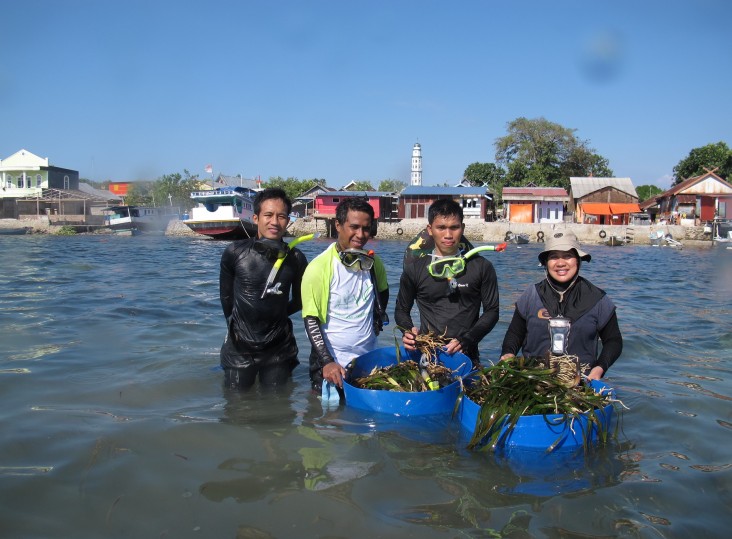Speeches Shim

Just below the water along Indonesia’s 34,000 miles of coastline, fields of green sway in vast underwater meadows. But they’re not seaweeds-- they’re seagrasses.
Seagrass meadows keep the ocean healthy and productive by providing food, shelter and breeding grounds for many kinds of fish and other marine creatures. “Not many people understand seagrass. They think it’s just grass [and] that it has no function,” said Rohani Ambo-Rappe, a lecturer at at Hasanuddin University in Makassar, Sulawesi, “but it’s actually a productive ecosystem. It’s really quite important.”
Twenty percent of the world’s seagrass grows in and around Indonesian waters. Nearly three million Indonesian households rely on the ocean for survival, and seagrass meadows are a hidden key to community wellbeing and economic growth. When seagrass thrives, local fishermen gain easy access to fertile fishing grounds that support their incomes and their families’ food supply. Seagrass meadows also support the fish that are exported to international markets, including to the U.S. But in recent years, the steady decline of seagrass has reached a critical state. As seagrass disappears due to human activities like overfishing, garbage pollution and unchecked coastal development, local fishermen have to go farther and farther to catch fish, spending more time and money to haul the same amount of catch.
Over three years, with support from the United States Agency for International Development’s (USAID) Partnerships for Enhanced Engagement in Research (PEER), Ambo-Rappe and her team of students collaborated with Susan Williams from the University of California at Davis to address this challenge. They set out to discover, in part, which seagrass species grows the fastest and survives the longest in support of Indonesia’s first major seagrass restoration effort: to cover over 30,900 square meters, nearly the size of six football fields, in Sulawesi with seagrass.
The seagrass they planted yielded excellent results: it grew taller and denser and drew plenty of fish, including high-value fish such as snapper and grouper. Ambo-Rappe and her team then created a restoration manual and trained local farmers to fight seagrass decline. “The people on these islands depend on the sea. We introduced the idea that seagrass, as a habitat for fish, indirectly provides them with fish. Then we showed them, step by step, how to restore it. The community wanted to participate; when we built the seagrass restoration plots, we asked them to help from the beginning.”
“We are proud to support partnerships between American and Indonesian scientists,” said USAID Education Office Director Peter Cronin. “Collaborative research such as this can lead to breakthrough solutions and scientific advancements that benefit us all.”
For Ambo-Rappe, participating in USAID PEER was essential to making her large-scale project possible. “USAID support provided a great opportunity for me to research and test restoration approaches while promoting knowledge of seagrass among local communities,” she said.
USAID PEER connects scientists in 50 developing countries with U.S. scientists to conduct joint research addressing global development challenges. USAID PEER is implemented in partnership with the U.S. National Academies of Sciences, Engineering and Medicine. U.S. scientists are funded by the Smithsonian Institution, NASA, and other U.S. government agencies. To date, USAID PEER has funded over 40 Indonesian researchers exploring topics such as child and maternal health, disaster preparedness, and ocean protection.
Please visit www.nationalacademies.org/peer for more.
For more, follow @USAIDIndonesia on Facebook, Exposure, Twitter and Flickr.
Story by Samantha Martin and Valli Chidambaram in memoriam of Susan Williams.

Comment
Make a general inquiry or suggest an improvement.